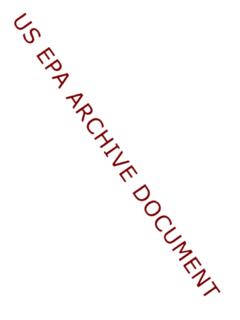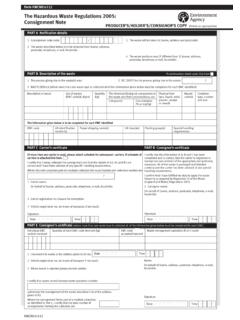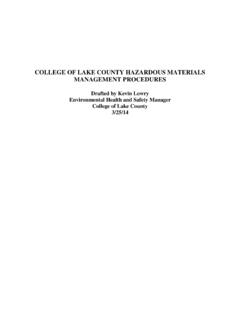Transcription of Training Module EPA530-K-05-012
1 Solid waste and Emergency Response (5305W). Training Module EPA530-K-05-012 . Introduction to hazardous waste identification (40 CFR Parts 261). United States Environmental Protection Agency September 2005. hazardous waste identification . CONTENTS. 1. Introduction .. 1. 2. Regulatory Overview .. 2. hazardous waste identification Process .. 2. Definition of hazardous waste .. 3. Listed hazardous 5. Characteristic hazardous Wastes Listed Solely For Exhibiting the Characteristics of Ignitability, Corrosivity, and/or Reactivity ..17. The Mixture and Derived-from Rules ..17. The Contained-in Policy ..21. 3. Regulatory The hazardous waste identification Final hazardous waste Listing Determinations ..25. Proposed Revision of Wastewater Treatment Exemption for hazardous waste Mixtures ..25.. hazardous waste identification - 1. 1. INTRODUCTION. "Is my waste a hazardous waste regulated under the Resource Conservation and Recovery Act (RCRA)?" This is one of the most common and basic RCRA questions and is the key to the RCRA hazardous waste program.
2 If something is not a hazardous waste , it is not regulated under RCRA. Proper identification of a hazardous waste can be a difficult and confusing task, as the RCRA regulations establish a complex definition of the term " hazardous waste ." To help make sense of what is and is not a hazardous waste , this Module presents the steps involved in the process of identifying, or "characterizing," a hazardous waste . While introducing the entire hazardous waste identification process, this Module will focus on the final steps, the definition of a hazardous waste . The other steps in the process, including the definition of solid waste and the solid and hazardous waste exclusions will be discussed in other modules. After reading this Module , you will be able to explain the hazardous waste identification process and the definition of hazardous waste , and be familiar with the following concepts: hazardous waste listings hazardous waste characteristics the "mixture" and "derived-from" rules the "contained-in" policy the hazardous waste identification Rules (HWIR).
3 The information in this document is not by any means a complete representation of EPA's regulations or policies, But is an introduction to the topic used for Training purposes. 2 - hazardous waste identification 2. REGULATORY OVERVIEW. What is a hazardous waste ? In its most basic form, the answer to that question can be quite simple. A hazardous waste is a waste with a chemical composition or other properties that make it capable of causing illness, death, or some other harm to humans and other life forms when mismanaged or released into the environment. Developing a regulatory program that ensures the safe handling of such dangerous wastes, however, demands a far more precise definition of the term. EPA therefore created hazardous waste identification regulations that outline a process to determine whether any particular material is a hazardous waste for the purposes of RCRA. hazardous waste identification PROCESS. Proper hazardous waste identification is essential to the success of the hazardous waste management program.
4 The RCRA regulations at 40 CFR require that any person who produces or generates a waste must determine if that waste is hazardous . In doing so, presents the steps in the hazardous waste identification process: Is the waste a "solid waste "? Is the waste specifically excluded from the RCRA regulations? Is the waste a "listed" hazardous waste ? Does the waste exhibit a characteristic of hazardous waste ? When faced with the question of whether or not a waste is regulated as hazardous under RCRA, turn to This regulation will remind you of the four steps in the RCRA hazardous waste identification process. IS THE waste A SOLID waste ? hazardous waste identification begins with an obvious point: in order for any material to be a hazardous waste , it must first be a waste . But, deciding whether an item is or is not a waste is not always easy. For example, a material (like an aluminum can) that one person discards could seem valuable to another person who recycles that material. EPA developed a set of regulations to assist in determining whether a material is a waste .
5 RCRA uses the term "solid waste " in place of the common term " waste ." Under RCRA, the term "solid waste " means any waste , whether it is a solid, semisolid, or liquid. The first section of the RCRA hazardous waste identification regulations focuses on the definition of solid waste . For this Module , you need only understand in general terms the role that the definition of solid waste plays in the RCRA hazardous waste identification process. Another Module , Definition of Solid waste and hazardous waste Recycling, explains the definition of solid waste in greater detail. IS THE waste EXCLUDED? Only a small fraction of all RCRA solid wastes actually qualify as hazardous wastes. At first glance, one would imagine that distinguishing between hazardous and nonhazardous wastes is a The information in this document is not by any means a complete representation of EPA's regulations or policies, But is an introduction to the topic used for Training purposes. hazardous waste identification - 3.
6 Simple matter of chemical and toxicological analysis. Other factors must be considered, however, before evaluating the actual hazard that a waste 's chemical composition poses. Regulation of certain wastes may be impractical, unfair, or otherwise undesirable, regardless of the hazards they pose. For instance, household waste can contain dangerous chemicals, like solvents and pesticides, but making households subject to the strict RCRA waste management regulations would create a number of practical problems. Congress and EPA exempted or excluded certain wastes, like household wastes, from the hazardous waste definition and regulations. Determining whether or not a waste is excluded or exempted from hazardous waste regulation is the second step in the RCRA hazardous waste identification process. Only after determining that a solid waste is not somehow excluded from hazardous waste regulation should the analysis proceed to evaluate the actual chemical hazard that a waste poses. The Module entitled Solid and hazardous waste Exclusions explains which wastes are excluded from hazardous waste regulation.
7 IS THE waste A LISTED hazardous waste , OR DOES IT EXHIBIT A. CHARACTERISTIC? The final steps in the hazardous waste identification process determine whether a waste actually poses a sufficient chemical or physical hazard to merit regulation. These steps in the hazardous waste identification process involve evaluating the waste in light of the regulatory definition of hazardous waste . The remainder of this Module explains the definition of hazardous waste in detail. DEFINITION OF hazardous waste . A discussion of the definition of hazardous waste should begin with Congress' original statutory definition of the term. RCRA 1004(5) defines hazardous waste as: A solid waste , or combination of solid waste , which because of its quantity, concentration, or physical, chemical, or infectious characteristics may (a) cause, or significantly contribute to, an increase in mortality or an increase in serious irreversible, or incapacitating reversible, illness; or (b) pose a substantial present or potential hazard to human health or the environment when improperly treated, stored, transported, or disposed of, or otherwise managed.
8 This broad statutory definition provides a general indication of which wastes Congress intended to regulate as hazardous , but it obviously does not provide the clear distinctions necessary for industrial waste handlers to determine whether their wastes pose a sufficient threat to warrant regulation or not. Congress instructed EPA to develop more specific criteria for defining hazardous waste . There are therefore two definitions of hazardous waste under the RCRA. program: a statutory definition and a regulatory definition. The statutory definition cited above is seldom used today. It served primarily as a general guideline for EPA to follow in developing the regulatory definition of hazardous waste . The regulatory definition is an essential element of the current RCRA program. It precisely identifies which wastes are subject to RCRA waste management regulations. The information in this document is not by any means a complete representation of EPA's regulations or policies, But is an introduction to the topic used for Training purposes.
9 4 - hazardous waste identification Congress asked EPA to fulfill the task of developing a regulatory definition of hazardous waste by using two different mechanisms: by listing certain specific wastes as hazardous and by identifying characteristics which, when present in a waste , make it hazardous . Following its statutory mandate, EPA developed a regulatory definition of hazardous waste that incorporates both listings and characteristics. hazardous waste LISTINGS. A hazardous waste listing is a narrative description of a specific type of waste that EPA. considers dangerous enough to warrant regulation. hazardous waste listings describe wastes from various industrial processes, wastes from specific sectors of industry, or wastes in the form of specific chemical formulations. Before developing a hazardous waste listing, EPA thoroughly studies a particular wastestream and the threat it can pose to human health and the environment. If the waste poses enough of a threat, EPA includes a precise description of that waste on one of the hazardous waste lists in the regulations.
10 Thereafter, any waste fitting that narrative listing description is considered hazardous , regardless of its chemical composition or any other potential variable. For example, one of the current hazardous waste listings reads as: "API separator sludge from the petroleum refining industry." An API separator is a device commonly used by the petroleum refining industry to separate contaminants from refinery wastewaters. After studying the petroleum refining industry and typical sludges from API separators, EPA decided these sludges were dangerous enough to warrant regulation as hazardous waste under all circumstances. The listing therefore designates all petroleum refinery API separator sludges as hazardous . Chemical composition or other factors about a specific sample of API separator sludge are not relevant to its status as hazardous waste under the RCRA program. Using listings to define hazardous wastes presents certain advantages and disadvantages. One advantage is that listings make the hazardous waste identification process easy for industrial waste handlers.














